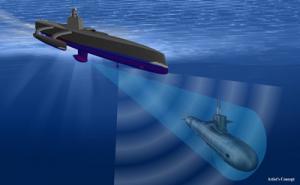Unmanned maritime systemsUnmanned Maritime Systems 2015 conference: “Reliability, Economy, Endurance”
The theme of the Unmanned Maritime Systems 2015 conference, being held 7-9 December 2015 in Arlington, Virginia, is “Reliability, Economy, Endurance: Requirements for Next-Generation Unmanned Surface and Undersea Systems.” The organizers note that there is a growing demand for Unmanned Maritime Systems (UMS) as today’s geopolitical environment poses a number of unique security challenges in the maritime domain. Advances in power, robotics, computing, sensors, and navigation technologies drive a growing DoD demand for unmanned systems that can provide increased autonomy, persistent resilience, and functionality with decreased risk and expense, showing their value across multiple applications, including otherwise dull, dirty, or dangerous missions.

Artist rendering of unmanned submarine hunter // Source: darpa.mil
The theme of the Unmanned Maritime Systems 2015 conference, being held 7-9 December 2015 in Arlington, Virginia, is “Reliability, Economy, Endurance: Requirements for Next-Generation Unmanned Surface and Undersea Systems.” The organizers note that today’s geopolitical environment poses a number of unique security challenges in the maritime domain. A strategic shift in U.S. national security priorities to the Asia-Pacific presents new operational considerations: potential adversary capabilities may require additional unmanned maritime systems to assure access to areas where freedom to operate is contested.
Additionally, advances in power, robotics, computing, sensors, and navigation technologies drive a growing DoD demand for unmanned systems that can provide increased autonomy, persistent resilience, and functionality with decreased risk and expense, showing their value across multiple applications, including otherwise dull, dirty, or dangerous missions.
The interest in unmanned maritime systems (UMSs) is thus growing, and as the technology improves and costs come down, more and more UMSs are performing more and more tasks.
Antoine Martin of Austin, Texas-based Unmanned Vehicle Systems Consulting LLC summarizes the main uses and benefits of UMSs:
UMSs make it possible to reach deep water energy sources. Drilling for oil and gas deep on the ocean floor is difficult and dangerous. After drilling is complete and production begins, there is need constantly to monitori operation to prevent environmental damage.
UMS can meet emerging maritime security threats. The growing threats of terrorists and piracy, growing Middle Eastern instability, territorial disputes in the East China Sea, and the rise of asymmetric warfare increase the need of countries for more secure littorals, ports, estuaries, channels, and bodies of water.
Military budget pressures favor UMSs. Reductions in the defense budgets of developed countries mean that many countries can no longer afford traditional maritime systems with their long development cycles and manpower requirements. UMSs offer navies the ability to reduce the number of people involved in maritime activities, reduce the risks to which military personnel are exposed, and develop smaller equipment, often relying on industry to take on the developmental costs.
Unmanned Aerial Systems (UASs) have by now gained wide acceptance. UASs have proven themselves reliable and capable of performing critical tasks. The proven record of UAS’s has made the acceptance of UMSs easier, and most countries using UASs have expanded their programs to include UMSs.
UMSs are especially suitable for mine countermeasures. Autonomous Underwater Vehicles (AUVs) and Mine Disposal Vehicles (MDVs) have proven their value over and over again in mine countermeasure operations, and are ready to be employed in other uses.
Climate change’s impact is here. Global warming is creating a navigable water way through the North Pole, offering a new route for shipping and naval strategy. Climate change is causing environmental disasters, with the accompanying economic and human cost. UMSs can be used better to understanding oceans’ dynamics, which translates into better preparation and adaption to climate change, and perhaps even making a contribution to preventing it from getting worse.
The following topics will be covered at the Unmanned Maritime Systems 2015:
- Requirements for modularity and interoperability in UMS
- Challenges in communication systems, spectrum, and resilience
- Improving persistent resilience to improve on-station time
- Requirements for increased autonomy in data collection, analysis, and planning
- Protecting critical technology and program information
- Forming consolidated plug-and-play standard performance and applications architecture
- Increasing system, sensor, and analytical autonomy to reduce supporting manpower
- Advantages to augmenting manned systems with unmanned systems in the maritime domain (MUM-T)
The organizers note that the scope of unmanned maritime technologies across multiple naval applications has grown in the last several years. The systems currently fielded to meet today’s operational demands need increased integration with existing systems to achieve greater efficiency and affordability. Additionally, reduced budgets continue to constrain DOD budgets makes achieving affordable and cost-effective technical solutions even more important.
Building open-architecture while leveraging commercial off-the-shelf (COTS) technology would allow increased economy, interoperability, and adaptability, thus improve existing systems by bringing greater automation and improved performance (SWaP), interoperability and modularity, survivability in contested environments (resilient communications), integration with manned systems (Manned-Unmanned System Teaming), and reduced manpower requirements to operate and support unmanned systems.
